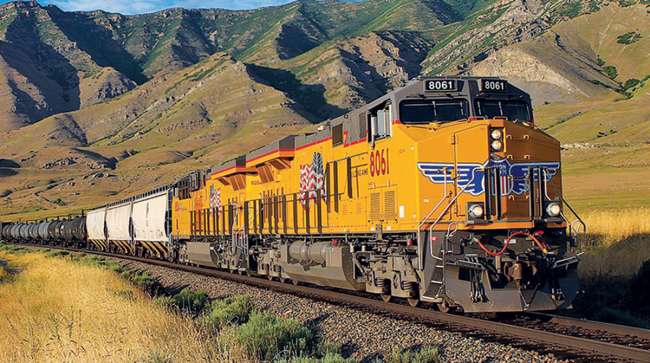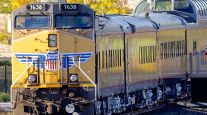Senior Reporter
Union Pacific Reports Flat Revenue, Income in Q1

[Stay on top of transportation news: Get TTNews in your inbox.]
Union Pacific Corp. reported flat year-over-year income and slightly increased revenue for the first quarter of 2023.
The Class I rail carrier on April 20 said that Q1 revenue rose 3% to $6.1 billion, compared with $5.9 billion a year ago. Income year-to-year remained flat at $1.6 billion, or $2.67 a share, compared with $1.6 billion, $2.58 a share, a year ago.
The company said Q1 was marked by softening freight volumes from customers along with rising costs, especially related to weather incidents such as record snow and rain in California. Inflation also was an issue during the quarter, it said.
“Volume is looking cloudy to us,” outgoing CEO Lance Fritz said during an April 20 conference call with analysts. “The story of the past quarter for Union Pacific is one of resiliency. Battling heavy snow, Arctic temperatures, flooding and tornadoes, the team maintained service levels and exited the quarter on a positive trajectory.”

Fritz
The company’s board of directors this month announced plans to hire a new CEO after a major shareholder stated displeasure with Fritz’s leadership. Fritz announced during the call that an outside search firm has been hired to assist in the recruiting process.
Fritz said he expects Union Pacific’s finances to improve during Q2 as it continues with a hiring blitz and gets more trainees working. He’s also hopeful for a break from weather-related troubles, and for some economic stability.
“We need consumers to continue to be healthy, spend some — they don’t have to go crazy,” Fritz said. “We need the industrial economy to continue to do what it’s doing, and we need inventory and this whole de-stocking to calm down after the first quarter or the first half. All those I think are pretty reasonable expectations.”
The railroad finished Q1 with nearly 1,300 more employees than it had this time last year, up more than 4% at 31,471 compared with 30,189 a year ago. Of those, nearly 11,900 are train, engine and yard employees, a 5% year-over-year increase. Fritz said the railroad has more than 1,000 new employees in training, double the number of new hires it was onboarding this time last year.
The railroad’s operating ratio worsened to 61.1 from 59.4 a year ago. Operating ratio, or operating expenses as a percentage of revenue, is used to measure efficiency. The lower the ratio, the greater the company’s ability to generate profit.
All of the major railroads continue to face scrutiny in the aftermath of a Norfolk Southern train derailment in East Palestine, Ohio, that resulted in ground, air and water contamination. In that incident, a freight train carrying toxic chemicals derailed after a wheel overheated.
Union Pacific ( $UNP ) Reports First Quarter 2023 Results https://t.co/XD90PfLY5l — Union Pacific (@UnionPacific) April 20, 2023
The Federal Railroad Administration is recommending that railroads update their policies and rules on how trains are assembled to lower the risk of accidents. Fritz said Union Pacific has more than 7,000 wayside detectors in its system, and said the industry supports additional funding to develop newer, better detectors and put more of them on rails.
However, Fritz pushed back on critics who insist that freight trains are becoming too long. He said regulating the number of crew members on trains and the length of trains would not improve safety. He noted that since 2019 the average length of Union Pacific trains has increased by 20%, while mainline and siding derailments — those that take place outside rail yards — have declined 26%.
“There’s zero corollary between train length and derailments,” Fritz said. “In engaging the legislators in D.C., we help them understand what would actually move the ball in terms of safety, where regulatory efforts would make a difference and where it wouldn’t.”
Revenue for Q1 across the railroad’s business lines, grain and grain products increased by 8% to $943 million compared with $877 million a year ago.
Want more news? Listen to today's daily briefing above or go here for more info
Fertilizer revenue notched up 3% to $186 million from $180 million last year.
Food and refrigerated cargo declined 1% to $263 million from $267 million in 2022.
Coal and renewable energy product revenue declined by 1% to $505 million from $508 million.
Industrial chemicals and plastics increased 3% to $536 million compared with $520 million.
Metals and minerals jumped 11% to $536 million from $485 million last year.
Forest products decreased 9% to $332 million from $364 million.
Energy and specialized markets increased 11% to $613 million from $552 million.
Automotive shipment revenue surged 17% to $587 million from $501 million.
Intermodal revenue dipped 3% to $1.155 billion from $1.186 billion,
Premium cargo increased 3% to $1.742 billion compared with $1.687 billion a year ago.




